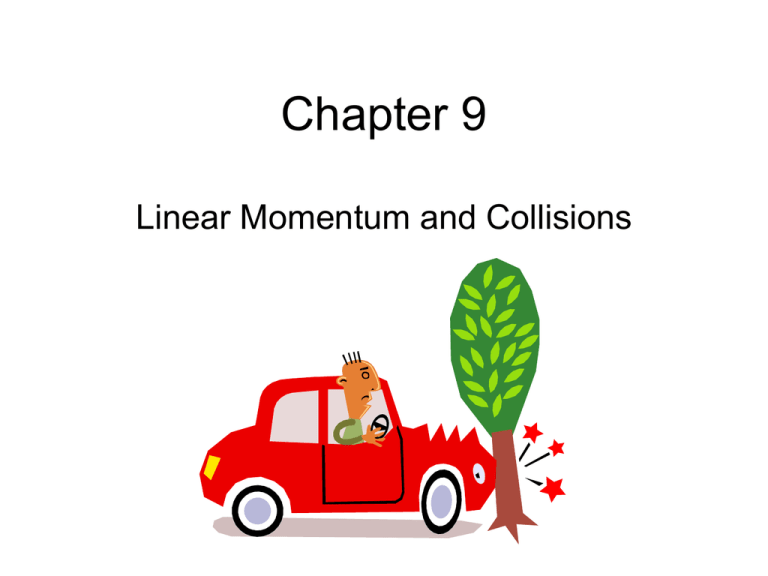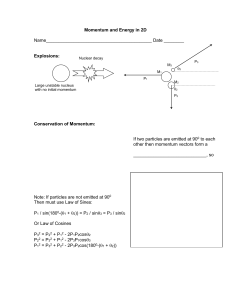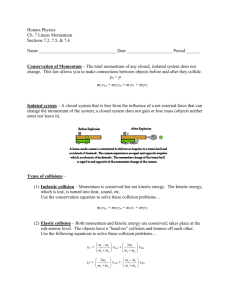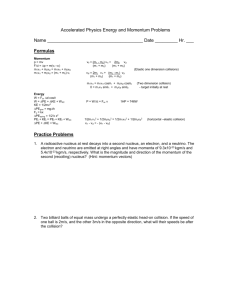Document
advertisement

Chapter 9 Linear Momentum and Collisions Consider an isolated system consisting of just two particles. If a force from particle 1 acts on particle 2, then a force of the same magnitude from particle 2 acts on particle 1 (by Newton’s third law). v1 m1 F21 F12 m2 v2 Two isolated particles interacting with each other. Newton’s third law ensures that F12= -F21. Some math... F21 F12 0 m1a1 m2a2 0 dv1 dv 2 m1 m2 0 dt dt d ( m1v1 ) d ( m2 v 2 ) 0 dt dt d (m1v1 m2 v 2 ) 0 dt What can we say about m1v1 + m2v2 if its derivative is zero? m1v1 + m2v2 is a constant as long as the system remains isolated. Definition: The linear momentum of a particle or an object that can be modeled as a particle of mass m moving with a velocity v is defined to be the product of the mass and velocity. p mv We can write Newton’s second law in terms of momentum. dv d dp F ma m dt dt (mv) dt The time rate of change of the linear momentum of a particle is equal to the net force acting on the particle. Conservation of momentum d (m1v1 m2 v 2 ) 0 dt Therefore, if two (or more) particles in an isolated system interact, the total momentum of the system remains constant. In other words, the total momentum of an isolated system at all times equals its initial momentum. p1i + p2i = p1f + p2f pix = pfx piy = pfy piz = pfz Practice Problem: Archery on ice A 60.0 kg archer stands at rest on frictionless ice and fires a 0.50 kg arrow horizontally at 50 m/s. With what velocity does the archer move across the ice after firing the arrow? Impulse and momentum Suppose a single force F acts on a particle. Then we know F = dp/dt, or dp Fdt which we can integrate to figure out the change in momentum when the force acts over some time interval. The impulse-momentum theorem tf I p Fdt ti The impulse of the force F acting on a particle equals the change in momentum of the particle. Since the force imparting an impulse generally varies with time, we can define impulse in terms of the time-averaged force. tf 1 F Fdt t ti Therefore, This is the mean value theorem of calculus. t = tf – ti, I Ft Often times, we can approximate the force acting on an object as constant, especially if the force acts for a short time. Then, I = Ft. This is called the impulse approximation, in which we assume that one of the forces exerted on a particle acts for a short time but is much greater than any other force present. Example: The collision of a baseball and the bat. The time of the collision is very short (about 0.01 s) and the average force the bat exerts on the ball is very large (1000s of Newtons). Therefore we are justified in ignoring the gravitational force when analyzing the collision using the impulse-momentum theorem. Quick Quiz Two objects are at rest on a frictionless surface. Object 1 has a greater mass than object 2. When a constant force is applied to object 1, it accelerates through a distance d. The force is removed from object 1 and applied to object 2. At the moment when object 2 has accelerated through the same distance d, which statements are true? a) b) c) d) e) f) p1 < p2 p1 = p2 p1 > p2 K1 < K2 K1 = K2 K1 > K2 Quick Quiz Two objects are at rest on a frictionless surface. Object 1 has a greater mass than object 2. When a constant force is applied to object 1, it accelerates for a time interval t. The force is then removed and applied to object 2. After object 2 has accelerated for the same time interval t, which statements are true? a) b) c) d) e) f) p1 < p2 p1 = p2 p1 > p2 K1 < K2 K1 = K2 K1 > K2 Practice problem A ball of mass 0.150 kg is dropped from rest from a height of 1.25 m. It rebounds from the floor to reach a height of 0.960 m. What impulse was given to the ball by the floor? Collisions in one dimension An elastic collision between two objects is one in which the total kinetic energy as well as total momentum of the system is the same before and after the collision. An inelastic collision is one in which the total kinetic energy of the system is not the same before and after the collision, even though the total momentum is conserved. Perfectly inelastic: the objects stick together after the collision Inelastic: the objects do not stick together The momentum of the system is conserved in all collisions, but the kinetic energy is conserved only in elastic collisions. The perfectly inelastic collison Before Collision m1 v1i v2i m2 After Collision m1 m2 vf m1v1 m2 v 2 (m1 m2 ) v f The perfectly elastic collision m1 v1i v2i v1f m1 m2 Before Collision m2 v2f m1v i1 m2 v i 2 m1v f 1 m2 v f 2 1 1 1 1 2 2 2 m1v1i m2v2i m1v1 f m2v22 f 2 2 2 2 After Collision (conservation of momentum) (conservation of energy) Quick Quiz In a perfectly inelastic one-dimensional collision between two objects, what condition alone is necessary so that all of the original kinetic energy of the system is gone after the collision? a) The objects must have momenta with the same magnitude but opposite direction b) The objects must have the same mass c) The objects must have the same velocity d) The objects must have the same speed, with velocity vectors in opposite directions The ballistic pendulum can be used to measure the speed of a fast-moving projectile, such as a bullet. A bullet of mass m1 is fired into a large block of wood of mass m2 suspended from some wires. The bullet gets stuck in the block, and the entire system swings through a height h. Find the speed of the bullet in terms of h and the two masses. Two dimensional collisions p1i + p2i = p1f + p2f pix = pfx piy = pfy piz = pfz The key to solving problems involving two dimensional collisions is to realize that the momentum in each individual direction is conserved. Practice Problem An unstable atomic nucleus of mass 17.0 X 10-27 kg initially at rest disintigrates into three particles. One of the particles, of mass 5.00 X 10-27 kg, moves in the y-direction with a speed of 6.00 X 106 m/s. Another particle of mass 8.40 X 10-27 kg, moves in the xdirection with a speed of 4.00 X 106 m/s. a)Find the velocity of the third particle b)Find the total kinetic energy increase in the process. Trickier practice problem After a completely inelastic collision, two objects of the same mass and same initial speed move away together at half their initial speed. Find the angle between the initial velocities of the objects. Hint: Choose your x and y directions carefully! The center of mass y m1 m2 ... mi ... mN x Suppose we have N number of particles of different masses lined up on the x-axis as shown. We define the center of mass as N xcm m1 x1 m2 x2 ... mN xN m1 m2 ...mN m x i i i 1 M where M is the total mass of the system of particles. This can easily be extended to 2-D and 3-D by computing ycm and zcm. Practice Problem Find the center of mass of the three particles shown in the figure: p1 = (3.0, 2.0), m1 = 6.0 kg p2 = (4.0, -4.0), m2 = 2.0 kg 8 p3 = (-2.0, 7.0), m3 = 4.0 kg 6 4 2 0 -2 -4 -3 -2 -1 0 1 2 3 4 5 6 7 8 Example: Earth-moon barycenter Find the center of mass of the Earth-moon system. ME= 5.98 X 1024 kg, MM = 7.36 X 1022 kg, and their centers are 3.84 X 105 km apart. This point is called the barycenter and the motion of the Earth and moon around it has important consequences for studying phenomena such as tides. Symmetry Symmetry can make calculating the center of mass a whole lot easier. (-x3,-y3) (-x2,-y2) (-x1,-y1) (x1,y1) (x2,y2) (x3,y3) Consider 6 particles all of mass m arranged in a circle. Symmetry ensures that everything cancels out if we choose the origin at the center of the circle. The center of mass is at the center of the circle. Motion of the center of mass In general, 1 rcm M miri i ˆ Where, rcm xcmˆi ycmˆj zcmk is the displacement vector of the center of mass. By differentiating we can determine the velocity and acceleration of the center of mass. 1 v cm M mi vi i 1 acm M miai i Notice that these are vector equations, which means we can break them up into components. Suppose Fi is the sum of all the forces acting on the ith particle in our system. Then, by Newton’s second law, Fi = miai. 1 acm M Macm 1 i miai M (F1 F2 ... FN ) F1 F2 ... FN Remember, each F is the sum of all the forces acting on that particular particle (1, 2, ..., N). Now, we do something clever. We will break up the sum of the forces on each particle into the sum of the external forces on that particle, FiE, and the forces exerted by the other particles in the system. For instance, E F1 F1 F12 F13 ...F1N So we can write... E Macm F1 F2 ... FN ( F1 F12 ...F1N ) ... E (FN FN 1 FN 2 ... FN ( N 1) ) And since we’re dealing with a sum we can rearrange like so... E E E Macm (F1 F2 ...FN ) (F12 F21) (F13 F31) ... (FN ( N 1) F( N 1) N ) I believe my third law of motion can help simplify things here. E E E External Macm F1 F2 ...FN F The center of mass of a system of particles acts as if it were a particle of mass M moving under the influence of just the external forces on the system. This is true in all cases. The particles could be a blob of silly putty, a gas, or a rigid body. It can be anything! Example: Two colliding asteroids Two asteroids are initially at rest relative to each other. Due to gravitational attraction, they eventually collide. If external forces are negligible, where do the asteroids collide? d = 1.0 X 107 m M1 = 8.0 X 1010 kg M2 = 2.0 X 1010 kg Example: The exploding rocket A rocket is fired vertically upward. At the instant it reaches an altitude of 1000 m and a speed of 300 m/s, it explodes into three fragments having equal mass. One fragment continues to move upward with a speed of 450 m/s. The second fragment has a speed of 240 m/s and is moving east right after the explosion. What is the velocity of the third fragment right after the explosion? Example: a proton-proton collision A proton collides elastically with another proton that is initially at rest. The incoming proton has an initial speed of 3.50 X 105 m/s and makes a glancing collision with the second proton*. After the collision, one proton moves off at an angle of 370 to the original direction of motion, and the second deflects at an angle of to the same axis. Find the final speeds of the two protons and the angle . v1f Before After v1i = 3.50 X 105 m/s 370 v2f * The two protons do not actually come into direct contact with one another. They interact through a repulsive electric force.






